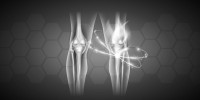
Multi-omics approach to diagnose joint infections
Let us talk about the use and the effectivness of multi-omics in diagnosing periprosthetic joint infections and arthroplasty failure.
In cases of osteoarthritis and other inflammatory joint diseases or joint damage due to injuries, tumors, or osteoporosis, it may be necessary to replace the damaged joint and perform a so-called total joint arthroplasty. Replacement of a diseased hip joint (total hip arthroplasty) and replacement of a knee joint (total knee arthroplasty) are the most common types of joint arthroplasty. It is assumed that the number of operations will increase due to the aging population and increasing physical activity.
The good thing is: Most patients have a successful outcome. However, 1% to 3% of patients require a repeat or extension of the procedure performed (revision surgery) due to complications such as periprosthetic joint infection (PJI) or failure to restore joint function (non-infectious arthroplasty failure or NIAF).
The rate of revision is increasing, especially in younger patients. Periprosthetic joint infection, in which the prosthesis-bearing bone and/or the affected joint space is infected with bacteria, occurs in 1-3% of patients, and is responsible for 20-50% of arthroplasty failures. It is a devastating complication that requires antimicrobials and surgical intervention to treat and is estimated to cost hospitals $2 billion per year. Risk factors for the infection include obesity, smoking, and immune-disrupting diseases such as diabetes and also rheumatoid arthritis.
Seeking a definitive diagnosis: the challenges of periprosthetic joint infection and non-infectious arthroplasty failure
A recently published review provides a brief overview of current approaches to diagnosing arthroplasty failure, including pioneering combined multi-omics methods that detect pathogens and evaluate biological responses to determine the cause of arthroplasty failure.
Arthroplasty failures, particularly periprosthetic joint infections (PJI) and aseptic loosening, in which abrasion particles or a lack of initial stability are responsible for the later loose hip, have significant health and also financial implications. Nevertheless, there is currently no universally accepted definition or diagnostic criteria for infection and prosthesis loosening. While several organizations have proposed diagnostic guidelines, these approaches are still being developed and refined. Diagnostic tests for periprosthetic infection are either microbial (bacterial cultures, molecular testing) or host-based (histopathologic evaluation, measurement of host biomarkers).
Microbial-based methods, such as bacterial cultures and molecular assays, have limitations, such as sensitivity, difficulty in determining whether isolated microorganisms are pathogens or contaminants, and time to obtain results. Molecular assays can have higher sensitivity than culture-based assays, but can also detect contaminants and clinically insignificant bacterial components. Host-based methods have their limitations, such as the need to collect multiple samples to obtain accurate results. Another challenge is the difficulty in distinguishing between loosening and infection. A single accurate test to differentiate would be very helpful in clinical practice, but a global consensus on the definition of PJI has yet to be found.
Transcriptomic and proteomic analyses
Diagnosis of arthroplasty failure can be difficult in some cases, but immune response profiling can distinguish between prosthetic joint infection (PJI) and noninfectious arthroplasty failure (NIAF) and potentially identify subsets. Transcriptome and proteomic analyses were performed to investigate the immune response in arthroplasty failure. Transcriptomic studies revealed increased expression of antimicrobial and immune cell activating genes in PJI. In contrast, proteomic studies revealed increased levels of antimicrobial inflammatory proteins in PJI and tissue homeostasis-related proteins in NIAF. Both transcriptomic and proteomic analyses identified several potential biomarkers for PJI.
Regarding transcriptomics, the researchers summarize: "In all, 28 previously described potential PJI biomarkers and three novel potential biomarkers, including CCL20 [...] and [...] (FCRL4), were elevated in PJI compared to NIAF."
As for proteomics, they say:
 In all, fifteen proteins were elevated in PJI, including lactotransferrin, lipocalin, myeloperoxidase, calprotectin A8 and A9 subunits, cathepsin G, neutrophil elastase […]. Twenty proteins were elevated in NIAF, including cartilage acidic protein 1 (CRTAC1), melanoma cell adhesion molecule (MCAM), IFI30 lysosomal thiol reductase (IFI30) […] and cathepsin D.
In all, fifteen proteins were elevated in PJI, including lactotransferrin, lipocalin, myeloperoxidase, calprotectin A8 and A9 subunits, cathepsin G, neutrophil elastase […]. Twenty proteins were elevated in NIAF, including cartilage acidic protein 1 (CRTAC1), melanoma cell adhesion molecule (MCAM), IFI30 lysosomal thiol reductase (IFI30) […] and cathepsin D.
Multi-omics: The future of diagnosing periprosthetic joint infections and arthroplasty failure
The future of PJI and NIAF diagnosis may be enhanced by multi-omics techniques that characterize the immune response during endoprosthesis failure. These techniques can be used in combination with computational tools such as machine learning and artificial intelligence for individualized diagnosis. Advanced computational studies have been performed to better understand their potential utility in predicting PJI. Simultaneous assessment of host response and detection of microorganisms may provide insight into the causes of arthroplasty failure. Plus, it also may enable precise treatment. Further development of diagnostic tools for arthroplasty failure is a challenge that requires continued research.